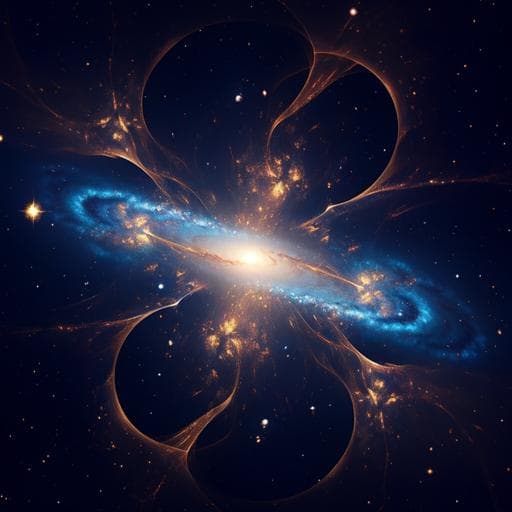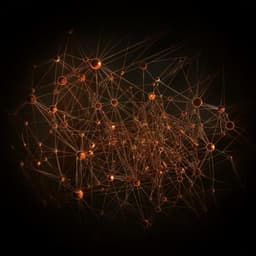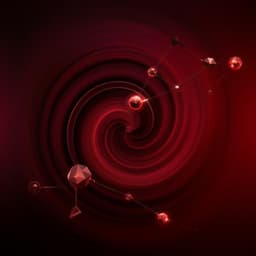
Physics
Penning-trap measurement of the Q value of electron capture in $^{163}$Ho for the determination of the electron neutrino mass
C. Schweiger, M. Braß, et al.
This groundbreaking research by Christoph Schweiger and colleagues unveils a remarkably precise Q value for electron capture in $^{163}$Ho, significantly enhancing our understanding of neutrino mass determination with sub-electronvolt sensitivity. Discover how this pivotal advancement surpasses previous measurements by over 50-fold!
~3 min • Beginner • English
Introduction
Neutrino oscillation observations establish that neutrinos are massive, but oscillation experiments measure only mass-squared differences, leaving the absolute mass scale unresolved. Cosmological analyses bound the sum of neutrino masses to below about 120 meV c2, while direct kinematic methods provide model-independent limits by studying decay kinematics without detecting the neutrino. The most stringent direct limit on the electron antineutrino mass (0.8 eV c2 at 90% CL) comes from KATRIN using tritium β-decay. A complementary direct approach is to analyze the electron capture decay of 163Ho with cryogenic microcalorimeters (ECHo and HOLMES). In these experiments, an accurate and independent Q value (energy release) is essential to quantify and control systematic effects in the extraction of the neutrino mass from the calorimetric spectrum. The research question addressed here is to determine the Q value of 163Ho → 163Dy + ν via a direct, high-precision, model-independent measurement, enabling sub-eV sensitivity in neutrino mass from electron-capture calorimetry.
Literature Review
The paper situates its contribution among several strands: cosmology provides a strong, model-dependent bound on the sum of neutrino masses (<120 meV c2). Direct kinematic methods include β-decay, with KATRIN achieving 0.8 eV c2 sensitivity, and earlier calorimetric efforts (MANU, MIBETA) that yielded limits of 19 and 15 eV c2. Current calorimetric programs, ECHo and HOLMES, target the 163Ho electron-capture spectrum aiming for sub-eV sensitivity; existing limits from ECHo are at the <150 eV c2 level. For mass-difference (Q value) determinations, Penning-trap mass spectrometry has proven capable, including prior work (SHIPTRAP) measuring Q(163Ho) = 2,833 ± 34 eV. The necessity of an independent, precise Q value arises to benchmark and constrain systematic uncertainties in calorimetric analyses where 163Ho is embedded in detector materials, potentially affecting spectral interpretation.
Methodology
The Q value is determined from the mass difference between 163Ho and 163Dy via precision cyclotron frequency ratio measurements of highly charged ions (HCIs) in a Penning trap and theoretical calculations of electronic binding-energy differences for the stripped electrons. Experimental setup: The PENTATRAP spectrometer (Max-Planck-Institut für Kernphysik, Heidelberg) comprises a 7 T superconducting magnet with a stack of five identical cylindrical Penning traps operated at ~4 K and equipped with non-destructive image-current detection in traps 2 and 3. 163Ho (radioisotope produced by neutron irradiation of 162Er) and stable 163Dy samples were converted to HCIs in a compact room-temperature TIP-EBIT optimized for small sample sizes. Only ~2 × 10^5 atoms of 163Ho were used. Extracted ions at 4.4 keV·q were transported through an electrostatic beamline; individual charge states n = 38, 39, 40 were selected with a Bradbury–Nielsen gate. Prior to trapping, ions were decelerated to a few eV/q using timed drift-tube pulses and captured in the trap stack. Measurement procedure: The traps 2 and 3 served as measurement traps; traps 1 and 4 as storage. A measurement cycle began by loading a set of three ions in order Dy (trap 2), Ho (trap 3), Dy (trap 4). Using resistive cooling and magnetron cleaning, single ions were prepared. The motional eigenfrequencies were measured employing single-dip, double-dip, and pulse-and-phase techniques: v− was measured once per day (double-dip), while the modified cyclotron (v+) and axial (vz) frequencies were measured simultaneously in traps 2 and 3 (pulse-and-phase for v+, double-dip for vz) during each cycle. The ions were then shuttled to swap species between traps 2 and 3, repeating the measurements to alternate Ho and Dy data. The free-space cyclotron frequency vc was reconstructed using the invariance theorem vc^2 = v+^2 + v−^2 + vz^2. Environmental stabilization (lab temperature to 0.1 K/day, stable He level/pressure) limited magnetic field drift to a few 10^−10 per hour; data were taken during low-disturbance periods. Data analysis: Because of slow magnetic field drift (flux creep), Dy cyclotron frequencies were linearly interpolated to the time of Ho measurements to compute instantaneous ratios R = vc(Dy^q+)/vc(Ho^q+). Residual nonlinearity in magnetic-field drift was assessed by interpolating the data onto themselves and including the mean residual per point as an added uncertainty to each ratio. For each charge state and trap, ratios were combined via weighted averages; the larger of inner and outer errors (Birge ratio method) was taken as the final statistical uncertainty. Systematic effects (relativistic shifts, trap field imperfections/anharmonicities, image-charge shifts, dip lineshape, and combined electric/magnetic gradient terms) largely cancel due to the nearly identical mass-to-charge ratios of Dy and Ho (difference ~10^−5). Residual systematic uncertainty in R was constrained below 10^−12. Potential shifts from long-lived metastable electronic states in HCIs were probed by measuring three charge states; consistency across q excludes such biases at the achieved precision. Atomic theory for binding-energy differences: The Q value requires adding the binding-energy difference ΔEB between the removed electrons in Ho and Dy for the chosen charge state. Three independent relativistic many-body approaches were used: (1) Configuration interaction (CI) using Quanty with Kohn–Sham orbitals from FPLO as basis, including Coulomb and static Breit interactions; configuration spaces were expanded iteratively with single/double/triple excitations to higher principal quantum numbers with convergence/extrapolation used to estimate uncertainties (~1 eV). (2) Multiconfiguration Dirac–Hartree–Fock (MCDHF) with GRASP2018, constructing CSFs via single/double excitations into a systematically expanded virtual orbital set (up to ~10h), assessing convergence and model spread; Brillouin–Wigner MBPT and QED corrections (Breit, Uehling, screened self-energy via model operator/Welton) were included. (3) MCDFGME calculations as an independent cross-check, using optimized-level mode with full relaxation; inclusion of Breit to all orders in correlation and Uehling potential; screened self-energy models tested. The final ΔEB values used were weighted averages of CI and MCDHF results, with uncertainties chosen as the larger of inner/outer errors (and accounting for correlations), and found consistent with MCDFGME and recent independent calculations. Q-value computation: For each charge state q = 38, 39, 40, the measured frequency ratio R and ΔEB were combined using Q = mref (R − 1) + ΔEB, where mref is the Dy HCI mass evaluated from the atomic mass of neutral 163Dy minus masses and binding energies of the missing electrons. The three Q values were combined via weighted average to yield the final result.
Key Findings
• Free-space cyclotron frequency ratios measured for three charge states (weighted averages): q = 38: R = 1.000000018623 with δR = 3.0 × 10^−10; q = 39: R = 1.000000011307 with δR = 4.1 × 10^−12; q = 40: R = 1.000000011516 with δR = 3.5 × 10^−12. • Final binding-energy differences ΔEB (weighted averages of CI and MCDHF): q = 38: 37.4 ± 1.4 eV; q = 39: 1,147.3 ± 0.7 eV; q = 40: 1,115.7 ± 0.7 eV. • Q values per charge state: q = 38: Q = 2,863.4 ± 1.5 eV c2; q = 39: Q = 2,863.2 ± 0.9 eV c2; q = 40: Q = 2,863.2 ± 0.9 eV c2. • Final combined Q value (weighted average across charge states): Q = 2,863.2 ± 0.6 eV c−2. • Precision improvement: more than 50-fold better than the previous direct Penning-trap value (SHIPTRAP: 2,833 ± 34 eV c−2). • Internal consistency across three charge states indicates negligible contributions from long-lived metastable HCI states and supports robustness of both the frequency-ratio measurements and the binding-energy calculations.
Discussion
The study delivers a precise, direct, and independent determination of the Q value for electron capture in 163Ho by combining high-precision Penning-trap cyclotron frequency ratios of nearly isobaric Dy/Ho HCIs with ab initio electronic binding-energy differences. This addresses the need for an external, material-independent Q value critical to interpreting calorimetric spectra of 163Ho implanted in detectors. The close agreement of Q determined independently for q = 38, 39, and 40 demonstrates that potential systematic effects—such as unknown long-lived metastable electronic states or imperfect drift interpolation—are negligible at the quoted precision. The result is in agreement within 1σ with the earlier SHIPTRAP measurement and within ~1.2σ of the AME 2020 value derived from microcalorimetry. This level of precision (0.6 eV) directly enables sub-eV sensitivity targets for neutrino mass in ongoing ECHo and HOLMES calorimetric experiments by tightly constraining the endpoint energy and reducing systematic uncertainty in spectral modeling.
Conclusion
By measuring the free-space cyclotron frequency ratios of 163Hoq+ and 163Dyq+ (q = 38, 39, 40) in the PENTATRAP experiment and combining them with precise electronic binding-energy differences from state-of-the-art atomic structure calculations, the Q value for 163Ho electron capture is determined to be 2,863.2 ± 0.6 eV. The cross-charge-state consistency and suppression of systematics validate the approach and provide a more than 50-fold improvement in precision over previous direct measurements. This independent Q value will enable cryogenic microcalorimetric experiments (ECHo, HOLMES) to assess and reduce systematic uncertainties and to pursue sub-eV neutrino mass sensitivity. Future work may focus on further reducing theoretical uncertainties in binding energies, exploring additional charge states or ions for cross-checks, and integrating these results into refined calorimetric spectral analyses.
Limitations
• The final Q value relies on theoretical electronic binding-energy differences; although multiple independent methods (CI, MCDHF, MCDFGME) were employed and cross-checked, residual theory uncertainties remain at the sub-eV level. • Magnetic-field drift is corrected via interpolation, with residual nonlinearity treated as an added uncertainty; unmodeled environmental fluctuations could, in principle, induce small biases. • The assumption that metastable electronic states do not affect all charge states equally is supported by consistency across q = 38, 39, 40; however, undetected states with identical energies across charge states would be challenging to exclude. • Systematic shifts (relativistic, field imperfections, image-charge) are estimated to cancel below 10^−12 due to the near-identical m/q, but any higher-order, species-dependent effects beyond current estimates would be difficult to detect. • The measurement used limited quantities of 163Ho and required long measurement times, making the approach resource-intensive.
Related Publications
Explore these studies to deepen your understanding of the subject.







